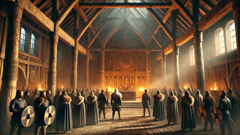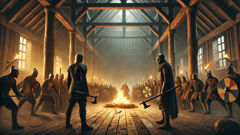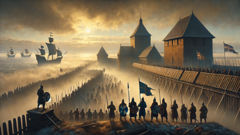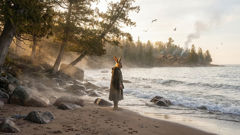Introduction
Long before the pages of history turned and the world’s maps took their modern form, the shores of the southern Baltic Sea thrummed with tales and thundered with the oars of dragon-prowed ships. At the heart of this wild frontier, where the cold, salt-laden winds tangled with the cries of gulls and the rolling green waves crashed onto ragged coasts, there stood the legendary stronghold of Jomsborg. The fortress, carved from timber and stone and ringed by daunting palisades, was more than just a sanctuary for warriors—it was the heart of a brotherhood whose very name, the Jomsvikings, became both a warning and a rallying cry across Scandinavia. Their saga begins not in the quiet of peace, but in the restless surge of ambition, where young men longed to carve their names into the bones of the earth and be remembered long after their sails faded from sight. Jomsborg rose from the dreams of these men—a brotherhood bound by oath, skill, and a relentless code, where the courage of one became the strength of all. As Denmark’s kings and Slavic princes jostled for power, and as Christianity’s banners began to flicker in pagan lands, the Jomsvikings carved out a realm of their own, swearing loyalty to no king but the laws they forged in the fire of shared battle. In the shadow of their high walls, destinies were decided by the sword and the ale horn, friendships were tested upon the anvil of loyalty, and legends sprang forth with the clash of iron. Yet, for all its might, Jomsborg was never just stone and timber. It was a living myth—a place where stories twisted with the wind and were shaped by the men who dared to call it home. This is their saga: the tale of Sigvaldi, the bold, of Bui the Thick, of Vagn Akason and Palnatoke, of love and betrayal, of rising tides and ruin. It is a saga of men who built an empire with nothing but their hands, their courage, and their will—and who watched it slip away like mist before the morning sun.
Founding Jomsborg: Oath and Ambition
Sigvaldi, son of the cunning Strut-Harald of Scania, was not content to live in the shadow of his father’s deeds. With eyes sharp as a hawk’s and a heart hungry for renown, he spent his youth in restless journeys across the North. The world then was a patchwork of chieftains and kings, where every stretch of coast was contested and alliances were as fleeting as summer storms. Yet Sigvaldi saw opportunity where others saw only chaos.

It was Palnatoke, the legendary archer and elder among warriors, who planted the seed. Over hornfuls of mead in a smoky hall near the Odense woods, he spun tales of a brotherhood that would be answerable to no king, ruled by their own laws and led only by the mightiest among them. Sigvaldi, enthralled, gathered like-minded men: orphans and outlaws, noble sons and battle-scarred mercenaries. They sought a place to root their dream—one beyond the reach of jealous kings and the growing shadow of the Cross.
They found it on the southern shore of the Baltic: a low, windswept spit where Danish lands met Slavic forests, bordered by treacherous shoals and deep, cold inlets. Local legends whispered of spirits in the woods and treasures lost to the sea, but Sigvaldi was undeterred. The men felled ancient oaks, lashed them with iron, and built walls thick enough to withstand siege. Watchtowers rose, wooden quays jutted into the surf, and halls for feasting and council sprang up amid the pines. At the heart stood the Great Hall—a place of law, judgment, and roaring celebration.
To join, a warrior swore the Jomsviking oath: never to flee in battle, to obey the chosen leader in all things, to seek vengeance for a brother’s death, and to accept no insult unanswered. The law was harsh but fair; any who wavered in battle or broke the code were cast out in shame. Their fame grew with every season. Merchants dared the fortress gates for protection, kings sought their blades as allies or hired foes, and rivals whispered their name with unease. Jomsborg’s banners—a black wolf on a white field—became both shield and warning.
The brotherhood was united by more than swords. In the long dark winters, stories were told beside roaring hearths. Bonds formed through shared hardship and laughter, blood spilled on distant shores, and the ever-present threat that tomorrow might be their last. Women were rare inside the fortress—Jomsvikings were forbidden to marry or bring wives inside the walls, and so the life was one of constant testing and discipline. Yet, even the hardest hearts could not keep longing at bay forever. Sigvaldi himself nursed a secret love for Astrid, daughter of a Slavic prince, a passion that would one day threaten everything he’d built.
Over time, Jomsborg’s strength drew both envy and fear. Rumors reached the Danish kings—Harald Bluetooth chief among them—of a fortress too mighty to ignore, a brotherhood beyond royal command. Envoys came and went, bearing gifts and veiled threats. Sigvaldi played a delicate game: accepting tribute, offering warriors for distant raids, yet never bending the knee. All the while, in the forests and along the cold Baltic coves, rival chieftains plotted. The seeds of greatness were sown—but so too were the seeds of destruction.
Brotherhood and Betrayal: The Fires Within
Years passed, and Jomsborg grew from a wooden outpost into an unrivaled citadel. Its walls withstood storms and raiders; its quays filled with ships whose sails painted the Baltic black and red. The brotherhood’s fame became legend—no force could match their discipline, no fortress could resist their siege. The world’s kings learned to fear or court them, sometimes both at once.

Within the walls, life was harsh but bracing. Training began before dawn: axes thudding against posts, arrows hissing through the mist. Meals were meager in winter and abundant in summer, but every warrior shared alike. The code was ironbound—no man could boast of past glory or quarrel over spoils; all were equals, judged only by valor and loyalty. Yet for all its unity, cracks began to appear, fine as frost lines on a window.
Sigvaldi’s secret love for Astrid festered into an open wound when her father, Prince Burislav, sought an alliance with Denmark’s king. Astrid was promised to another—a Saxon noble—and Sigvaldi’s heart grew heavy. The brotherhood sensed his distraction. Bui the Thick, steadfast and loyal but jealous of Sigvaldi’s command, began to whisper among the warriors. Vagn Akason, boldest of the young men, argued that the code must be absolute—that love and kinship outside the walls would ruin them all.
One autumn, word reached Jomsborg that King Harald Bluetooth demanded the fortress submit to his rule or face destruction. Sigvaldi summoned a council. The men gathered in the Great Hall, thunder rumbling over the sea. Should they bend the knee and preserve what they’d built, or defy Harald and risk annihilation? The debate was fierce, oaths shouted and accusations flung. Bui urged resistance; Vagn called for a test of will; Sigvaldi, torn by love and ambition, hesitated. In that moment, the brotherhood began to unravel.
The night that followed was restless. Ale flowed and tempers flared. Outside, the wind lashed at the walls; inside, loyalties shifted like sand. Bui accused Sigvaldi of weakness—of risking all for one woman. Vagn challenged him to single combat. The duel was fierce: iron rang against iron, sparks leapt in the firelight, and blood streaked the floor before Sigvaldi’s blade finally struck true. He spared Vagn, but the message was clear—Jomsborg would not waver.
Yet the wound did not heal. Bui and his supporters left the fortress at dawn, vowing to return only when Jomsborg was ruled by true warriors. Astrid, desperate, risked everything to warn Sigvaldi: Danish ships massed at Sjaelland, their sails black against the autumn sky. War was coming, and Jomsborg’s unity was already shattered. The fires that had warmed them through winter now threatened to consume them from within.
The Siege of Jomsborg: Storms on the Baltic
The first storm broke at dawn. Danish longships, hulls painted with snarling beasts, swept out of the mist like spirits of vengeance. Harald Bluetooth had gathered every rival he could bribe or threaten: Slavic warriors from the east, Saxons from the south, even Norsemen eager for spoils. Their sails blotted out the horizon, their war horns sent flocks wheeling into the gray sky.

Inside Jomsborg, Sigvaldi rallied those who remained. The fortress bristled with warriors—some grim with determination, others haunted by doubts sown in the long winter. Astrid moved among them, tending wounds and whispering encouragement. Atop the ramparts, archers strung bows and spearmen readied buckets of stones and tar. The code was clear: surrender was not an option.
The first assault crashed against Jomsborg’s walls like a tidal wave. Ladders battered the palisades; fire arrows arced overhead, setting roofs ablaze. The defenders answered with boiling pitch and spear thrusts. For three days, the attacks came—each wave more desperate than the last. Men fought until their arms trembled, until their voices were hoarse from screaming battle cries. At night, wounded were dragged from the walls, their blood pooling on frost-slick stones.
Bui returned in the dead of night, his followers battered but defiant. He’d seen the size of Harald’s host and knew there was no victory in pride alone. The brothers clasped arms beneath a full moon—old grudges set aside for survival. With Bui’s strength and Sigvaldi’s cunning, they devised a plan. At dawn, as the Danes prepared another assault, Jomsvikings burst from a hidden gate and struck the besiegers’ flank. The battle was chaos—steel flashing, shields splintering, cries of rage and agony echoing across the beach.
For a moment, it seemed the brotherhood might break the siege. Harald himself was nearly slain before loyal Saxons dragged him to safety. But fresh reinforcements arrived by sea, their numbers overwhelming. By sunset, the fortress walls were breached. Warriors fought room by room, hall by hall. Astrid was captured by Danish troops; Vagn fell defending the north tower; Bui was mortally wounded on the ramparts he’d once helped build. Sigvaldi, seeing defeat inevitable, gathered the last survivors and led them through a secret tunnel beneath the hall to the rocky shore beyond.
As flames devoured Jomsborg behind them, the Jomsvikings vanished into the Baltic mist—fewer than two dozen where once there had been hundreds. The fortress that had terrified kingdoms was now a pyre reflected in black water. Yet their legend would not die so easily. In every hall from Novgorod to Dublin, men would whisper of their courage, their brotherhood—and the price they paid for freedom.
Conclusion
Jomsborg’s charred stones settled into the earth, swallowed by moss and memory, but its saga endured far beyond the reach of time or tide. Survivors fled into legend—some to foreign courts as mercenaries, some to hidden valleys where oaths could be kept in secret. Sigvaldi lived on in stories as both hero and caution, his courage admired even as his flaws were whispered over mead horns. Astrid’s fate became a favorite tale: some claimed she escaped and founded a new line of warrior queens; others swore she wandered forever in search of lost love. Yet it was not their end that mattered most. Jomsborg’s true legacy was the brotherhood they forged—men bound not by blood or birthright, but by courage and the relentless pursuit of freedom. Their saga echoed through the centuries, inspiring rebels and dreamers wherever walls rose against the storm. In every whispered oath and every act of defiance, some trace of Jomsviking fire still flickers—reminding us that greatness is built as much on what we dare to risk as what we hope to keep.













